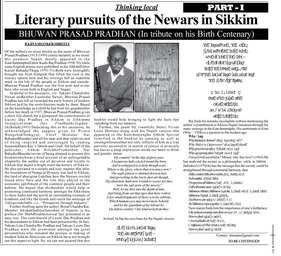
October 1, 2013
Literary pursuits of the Newars in Sikkim
Bhuwan Prasad Pradhan
In Tribute on his Birth Centenary
- Rajiva Shanker Shresta
Of the authors no more amidst us the name of Bhuwan Prasad Pradhan (1913-1999) comes instantly to my mind. His poems in Nepali mostly appeared in the Kanchanjungha (Editor Kashi Raj Pradhan 1958-70) while some English poems were published in the Sikkim (Editor Kaiser Bahadur Thapa 1970-71). Both were fortnightly brought out from Gangtok that filled the void in the literary sphere here and his writings left an indelible mark in the life of the people in Sikkim and outside. Bhuwan Prasad Pradhan was the first poet and writer here who wrote both in English and Nepali.
Grateful to his ancestors, viz. Taksari Chandrabir Newar and brother Laxmidas Newar, Bhuwan Prasad Pradhan has left us recorded the early history of modern Sikkim and for the contributions made by them. Based on the knowledge as a child he had from his grandmother before her death in 1937, Bhuwan Prasad Pradhan gives a short life sketch for a glimpse of the contributions of Laxmi Das Pradhan in Sikkim in Sikkimma Swargiya Laxmi Das Pradhanko Yogdan – Ek Jhalak (1993). Dedicating this to his ancestors, he acknowledged the support given by Prince Wangchuk Namgyal, Chief Minister Nar Bahadur Bhandari and all his near and dear relatives and of being inspired and encouraged by reading Sunanda Datta Ray’s Smash and Grab. On behalf of the publisher, Sikkim Bolchha Prakashan, Nar Bahadur Bhandari wrote of being pleased to present this booklet which was a brief account of an unforgettable chapter by the author out of devotion and loyalty to Sikkim that depict a bright era in the history of Sikkim. He also narrated in a simple and easy manner that after the foundation of Namgyal Dynasty was laid in Sikkim, the land of aborigine Lepchas, how the Newars invited found entry here and the role they played in the economic upliftment of the common people and their habitat. He hoped that this booklet would help in promoting communal harmony amongst the Sikkimese to show India and the world an outstanding example of kindness and like the Greek and reach the message of Udyogi sada Sukhi ,i.e., “Prosperity through Industry”.
Further dwelling upon the author, Bimal Chandra Rai, Member Sikshak Sahitya Sansthan of Namchi in his preface Dui Shabd finds historical fact presented in an easy way. The contribution of Laxmi Das Pradhan and his descendants to Sikkim had been praiseworthy. In fact, Taksari Late Chandra Bir Pradhan and Taksari Laxmi Das Pradhan were the prominent amongst the great personalities who initiated the process in making of modern Sikkim. Historians on Sikkim have not brought out this aspect to light. So, we can rest assured that this booklet would help bringing to light the facts fast vanishing from our memory.
My country! In the day of glory past,
A beauteous halo circled round thy brow.
And worshipped as a deity though wast,
Where is the glory, where that reverence now?
The eagle pinion is chained down at last,
And grovelling in the lowly dust art though,
Thy alinistral, hath now wreath to weave for thee,
Save the sad story of the misery?
Well, let me dive into the depth of time,
And bring from out that ages that have rolled,
A few small fragments of those wreeks sublime,
Which human eyes may never more behold,
and let the guardian of my labour be,
My fallen country! One kind wish from thee.
In brief, he has his own lines for the Nepali version:
मेरो देश ती बितेका दिनहरु
त्यो कति महत्वपूर्ण थियो –
पूजा गर्थे देवी जस्तै तिमीलाई
त्यो दिन कहाँ गयो, त्यो स्मृति?
वैरीले कहाँ लाग्यो तिम्रो पखेटा?
धुलोमा मिलाई त्यो इज्जत –
मेरोमा माला छैन लगाईदिनु
तिम्रो त्यो दुखःको कहानी सुन्दा
हेरुँ त्यो बितेका दिनहरु बितिसकेका घटना
त्यो सारा पुराना ठाऊँहरु l
ॐ “जय सिक्किम” ॐ
तपको भूमि स्वर्गको बाटो
यही हो हाम्रो देश l
बल र बुद्धि सम्पन्न भए
हाम्रो छ राम्रो देश ll
….
Rai finds his remarks incomplete without mentioning the author’s contribution to Sikkim Nepali literature through his many writings in the Kanchanjungha. His sentiments in Kina (Why – 1958) is a question to the modern age (with English version by this author for poems below) :
Why / किन ?
Why human is demon? मानव किन दानव भो ?
Why Ruler is Oppressor? शासक किन शोषक भो ?
Why greed in sacrifice, त्यागमा लोभ किन,
Why ego giving alms? दानमा अहंता किन ?
Paisa Tero Kasto Maya? Money why this love? (1965) He has analysed the money as a philosopher, while in Sikkim –Indrakeel (1970) he has the message that the society could be strengthened through communal harmony, thus
Hilly country, hilly dress पहाड़ी देश, पहाड़ी भेष
So beautiful, सौन्दर्य छटाले
Prosperous all Sikkim भरेको सारा, सिक्किमभरि
Full with many stars. अनेकौं ताराले ll
Sikkimese Bhutia, Sikkimese Lepcha, सिक्किमे भोटे सिक्किमे लाप्चे
Sikkimese Nepali, सिक्किमे नेपाली,
Tied but we are बन्धन तर हाम्रो छ घर
By Sikkimese rope together. सिक्किम डोरोले ll
Next stanza finds him the importance of one’s birthplace:
Like in heaven many rare flowers बैकुण्ठ सरि नपाउने फूल
Here we find अनेकौं यहीँ छ,
Crown of India भारतको मुकुट,
Confluence of Tibet तिब्बतसितको दोभान
Here we find. यहीँ नै पाइन्छ l
His poems in English, viz., The Faithful Dog, Sovereign Sikkim, Fatherland that appeared in the Sikkim reflect his love and respect for the motherland while through Whither he has brought the facts of life to the new generation. Heaven in Earth that appeared in the Kanchanjungha Sikkim Special Issue has full of praise for natural beauty Sikkim is adorned with while in another Ramarajya or Mobocracy (1970), we can have an idea of how unparalleled and sharp understanding he had of the politics. Here, he observed that in the name of politics, there were riots, disturbances, etc. everywhere – terror and disgust spread all over. Rai concludes his remarks with Fatherland that appeared in the Sikkim (1971):
Fatherland
Ever seen a citizen of State who has not a faith,
And uttered single word –
“This is my own Native land”*
He is not fit to live.
In the land where he is born, as from such a creature evils
Will sprout and cause havocs, unseen unknown and unheard
With results harmful to all where he is born and brought up.
Fie, to such infamy cross, opportunist in the garb of sheep,
Mark him well, let be no chance anywhere to sprout venoms:
Nip him in the budding stage, ye patriot,
As evils may not take roots deep in the virgin lands of
Godly Saints and lordly abodes.
*Sir Walter Scot in Patriotism
Bhuwan Prasad Pradhan has mentioned in this book that there were only four schools to start with in Sikkim – High School at Gangtok, Primary schools at Rhenock, Sadam and Sumbuk. Only the High School at Gangtok was run and managed by the Durbar and the rest were aided by the Christian Missionaries. He tells that the Sumbuk School was started by Rai Saheb Hari Prasad Pradhan in 1923 with an aid of Rs. 10/- from the Government and another Rs. 10/- from Sumbuk Court and by appointing James Singh Lepcha of Rhenock as its teacher. At one stage, bad condition of the school brought warning from the Director of Education S. R. Ghosh but soon it improved with management entrusted to his relative Kamal Prasad (Sailesh Chandra Pradhan’s father). With enrolment of students improved when requested for upgrading it, School Inspector K. L. Bamola asked for 5 acres of land needed for the junior high school. He donated his land and it was dream come true for him and his ancestors to see the High School there live and vibrant!
This author learnt from his mother Indira, youngest daughter of Rai Saheb Ratna Bahadur Pradhan - the elder son of Taksari Chandra Bir Pradhan of Rhenock that Bhuwan Prasad Pradhan used to frequently visit him for all family consultations and benefit of wise advice. He was the only link between the families of two brothers. Elder Taksari Laxmi Das, the first Municipal Commissioner of Darjeeling, settled and flourished in the south district while Chandra Bir with four wives at different parts in the east. Rai Saheb Ratna Bahadur Pradhan with younger brother Durga Shamsher Pradhan immortalized their father’s name establishing in 1910 the Chandra Nursery. This put the name of Sikkim in world floriculture map with Lady Linlithgow, wife of the Viceroy of India, when visited there in 1940. Laxmi Das’s eldest son Rai Saheb Hari Prasad Pradhan, who also became the Municipal Commissioner and practice there, was invited by King Tribhuvan to be sworn in as the first Chief Justice of Nepal. Both Rai Saheb Hari Prasad Pradhan and Bhuwan Prasad Pradhan are seen in the picture of that historical moment of the glorious days! This picture can be seen in my tribute The Chandra Nursery Centenary 1910-2010 in www.karunaguthi.com or in the Talk Sikkim August 2010 Gangtok Editor Mita Zulca.
Sharing the date of birth with the father of the Nation Mahatma Gandhi, Bhuwan Prasad Pradhan was born at Shumbhuk Kothi on the 2nd October 1913 to mother Heera Laxmi and Hiralal Kasaju, son of Ram Krishna and grandson of Taksari Laxmi Das Newar. He did his matriculation from the Government High School Darjeeling (Calcutta University) in 1932 He served the King’s Emergency Commission as a Cadet Officer in the British Indian Army -1939-40 – the First Hillman from Darjeeling District to obtain this. He established floriculture – Glen-leu Farm – cultivation of Gladioli – Gerbera, Amerlilies, etc. – Poultry farming – tomato farming encouraged the locals in this trade. His family was behind the Shumbhuk Primary School established by Late Rai Saheb Hari Prasad Pradhan in 1923 – continued this by providing additional land and other aids from time to time. Bhuwan Prasad was the landlord of Shumbhuk Estate and Rateypani Estate. He served the Chogyal’s Government as a Honorary Magistrate at Namchi for South Sikkim from 1952-1970(19 years) and was honoured with a certificate by the Chogyal of Sikkim Palden Thondup Namgyal for the distinguished services rendered on 4th April 1971. (Source: Dinesh Prasad Pradhan, 1998)
When posted at Namchi as the District Magistrate-cum-Collector of the South district, this author took the opportunity to visit and pay respect to Bhuwan Prasad Pradhan at his Sumbuk Kothi. Later, he also visited Kerabari-Melli with his parents to meet Chandra Jyoti Pradhan, elder son of Moti Chand Pradhan, another scion of Taksari Laxmi Das to be a link between us. Bhuwan Prasad is also known for his Glen Leu Farm, Sumbuk, Sikkim as some of his poems appeared with this address in the Himalayan Observer from Kalimpong Editor B. D. Basnett, perhaps. Or was it in the Sikkim Herald in 1970-71 Editor Dean Gasper because my article Wildlife of Sikkim, first ever here on the subject, too had appeared therein.
Bhuwan Prasad Pradhan passed away in 1999 at the age of 87. This article is in tribute to the departed writer-poet on his Birth Centenary this day and to the Father of the Nation Mahatma Gandhi on his 145th Birth Anniversary today.
----
Contact : [email protected]
Originally written on October 24, 2011


 RSS Feed
RSS Feed
